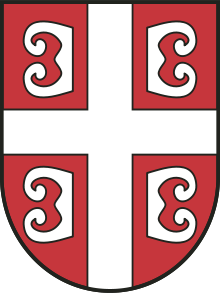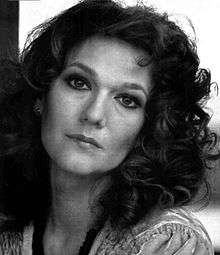Triestine Serbs
| ||||
| Total population | ||||
|---|---|---|---|---|
| (Around 15,000 (2011) [1]) | ||||
| Languages | ||||
| Serbian, Italian | ||||
| Religion | ||||
| Serbian Orthodox Church | ||||
| Part of a series of articles on |
| Serbs |
|---|
 |
|
Native communities |
|
Related people |
Triestine Serbs (Serbian Cyrillic: Тршћански Срби / Tršćanski Srbi; Italian: Serbi Triestini) are the indigenous ethnic Serbs of Trieste, present in the city since the 18th century.[2] They were a primary force behind the economic dominance of Trieste during the Habsburg period.
History
Serb merchants and ship-owners established a community in Trieste at the start of the 18th century, most primarily originating from Sarajevo, Trebinje, and the Bay of Kotor.[3] In 1751 Maria Theresa of the Austro-Hungarian Empire proclaimed religious freedom in the city, and the Serbs and Greeks of Trieste built the Saint Spyridon church that same year.[4] The most influential of the wealthy Serbian merchants of the time were the Kurtovic, Gopcevic, Vojnovic, and Miletic families, who owned most the structures and dock area of the "Porto Vecchio" (Grand Port).[2] In 1766 Trieste's Serbs numbered 50, by 1780 they grew to 200.[5]
Serbian School
In 1782 the Serbian community of Trieste began expressing its desire for a Serbian-language day school, a place for their children to be passed down Serbian culture and language. Jovan Miletic, a wealthy Serb merchant in Trieste, donated 24,000 florins to build a Serbian Elementary School in 1787. On July 1, 1792 the local government approved its opening and the "Jovan Miletic" private school began official operation, located in the city's old town, right beside the Saint Spyridon Church. A night school and reading room were opened in 1911.[2] In 1911 an asylum was added to the school, for Serbian political refugees, due to the constant warfare and bloodshed occurring between the Austro-Hungarian and Ottoman empires on the Balkan peninsula. The school represented a pillar of the Serbian community of Trieste, where all the children of the wealthy Serbian merchants went to school and integrated into the city's community. In 1973 the school was shut down due to lack of student enrollment and became a Sunday school for Serbian language and culture. Velimir Djerasimović, the school's principal and teacher since 1927, retired in 1973. Djerasimović is the father of Italian film stars Ivan Rassimov and Rada Rassimov.
Saint Spyridon Church
In 1782 the Serb Orthodox and Greek Orthodox communities of Trieste split due to major disagreements concerning church rituals and language-usage, at which point the Greek community built its own church, dedicated to Saint Nicholas in the baroque style, and the Serbs continued to use the original church of Saint Spyridon. In 1861 the Serb community demolished the original church, and rebuilt it in Serbo-Byzantine style , in order to "stamp their identity architecturally in the midst of a baroque Austro-Italian city".[6] The church's construction was completed seven years later, in 1868. With the added capacity for 1600 worshippers, it was for a long time the second largest Serbian church in the world. The church is filled with liturgical masterpieces of the time, works in gold from the 17th and 18th centuries, antique Orthodox icons and handmade books, making it an important monument to Serbian history and culture.[4] The church was designed by Italian architect Carlo Maciacchini, featuring four cupolas and one large main dome adorned in an off-blue color. In the 1800s the Serbian population in Trieste numbered around 200 people.[7]
Under Fascist Rule
In 1918 Trieste became part of Italy during the Unification of Italy led by Garibaldi and social life drastically changed for the Serbs and other minorities of Trieste. Due to the contentious national border with Slovenia, Italian society became increasingly hostile towards all Slavs in Trieste including the Serbs, and anti-Slavic racism began to flourish in Italy.[7] The anti-Slavic feelings were embodied by the precursor to the Italian Fascist Party: the Liberal-National Party of Italy. In Trieste the party was run by Giuseppe Cuzzi and its main focus was to make Trieste completely Catholic and Italian. The anti-Slavic propaganda focused on the idea that Slavic people were barbaric and could not integrate properly into a civilized society.[7] Tensions came to a hilt in World War Two, when the Italian Fascists built the only Nazi Extermination Camp in Italy, "Risiera di San Sabba", on the outskirts of Trieste. Three thousand Jews, Serbs and other Slavs were executed here in 1944 while thousands more were imprisoned awaiting transfer to other extermination camps.[8]
Monuments
Besides the Saint Spyridon Church and the Jovan Miletic Serbian School, the Serbs of Trieste contributed to several other important landmarks of the city. The Gopcevich family built the "Palazzo Gopcevich" on the Porto Vecchio, along the dock, made in 1850 in commemoration to the heroes who fought for the independence of Serbia from the Ottoman Empire (1814). Chrisoforo Popovich owned many famous merchant ships in Trieste, some of the largest in the Adriatic: the "Tartan", "Dalmatian Ferroce", "La Forza" and the "Ripatriato", and was instrumental to the Russian-side in the Crimean War (1853-1856). Christopher Scuglievich (Skuljevic) built the Palazzo Scuglievich in the mid-1800s along the banks of the port, and donated the palace in his will to the Serbian community of Trieste, today it is owned by the Serb community.[2]
Serbian Writers
The Serbian community of Trieste had a deep and long-lasting relationship with Serbian writers from the 18th century to today. Iconic Serbian writers and linguists such as Vuk Karadžić, Dositej Obradović, Petar II Petrović-Njegoš, Zaharije Orfelin and Pavle Solarić were inspired by Trieste and its developed Serbian community.[3] They wrote many works on Trieste's influence on Serbian "pre-Romanticism" and cultural development during a time when the Serbs lacked statehood and cultural expression. Serbian linguist and creator of the standardized Serbian language, Vuk Karadžić, kept in constant contact with Trieste's Serb community from his home in Vienna. In 1813 Vuk called upon the Triestan Serbs to subscribe to the Serbian-language newspaper, "Novine Serbske" promoting the newly standardized Serbian language, and more than sixty copies of the standard Serbian dictionary were bought in 1814.[3] The "father of contemporary Serbian literature" Lukijan Mušicki , wrote an ode to Serbian merchants of Trieste in 1835, and revolutionary writer Dositej Obradovic tutored the children of the wealthy Serb merchants.[3] Many Serbian poets and folklorists even worked in the Saint Spyridon Church for a time. An almost universal feeling of inspiration and admiration of Trieste's wealthy Serb community was shared by their Balkan-Serb contemporaries.
Modern Day
Today, Serbs represent the largest non-Italian community in Trieste, numbering around 10,000, although some figures state anywhere up to 18,000.[1] The overwhelming majority of Serbs in Trieste today descend from the immigration wave following the Yugoslav Wars of the 90s. Recently the Serb Orthodox Society in Trieste led by Bogoljub Stojičević has called on the local government to grant the Serb Community of Trieste cultural autonomy and reinstate the Jovan Miletić Serbian school as a full-time school since it downgraded to a Sunday school due to inactivity in 1973.[9] Since 2009 the Serbian community of Trieste, namely the Serbian Association "Vuk Karadzic", has been organizing an annual Balkan-style trumpet festival on the outskirts of Trieste called "Guca na Krasu" (Guca in Karst), modeled after the famous Guča Trumpet Festival in Serbia. Since its beginnings, the festival has managed to gain recognition and popularity, succeeding in getting famous musicians like Goran Bregović and Boban Marković, as well as many popular Italian acts.[10] The oldest active Serbian organization in Trieste is the soccer club "Serbia Sport", started in 1992, and since then has won a multitude of championships in the local Trieste soccer league, making it today one of the top soccer teams in the Trieste region. Together with the Serbian Association "Vuk Karadzic", Serbia Sport organizes an annual Serbian-Diaspora Soccer Tournament in Trieste on the Serbian holiday Spasovdan, which occurs 40 days after Easter.[11]
Notable people
See also
References
- 1 2 http://www.demo.istat.it/str2010/index03_e.html
- 1 2 3 4 Medakovic, Dejan (1987). Serbs in the history of Trieste.
- 1 2 3 4 Gorup, Radmila (Spring 2006). "Marija Mitrovic. Sul mare brillavano vasti silenzi: Imagini di Trieste nella letteratura Serba". Serbian Studies. 20: 203.
- 1 2 "People of Saint Spiridione: the cultural and religious legacy of the Serbians of Trieste". Retrieved 2014-06-11.
- ↑ Pavlowitch, Stevan K. (June 1961). "History of the Serbian Orthodox Church community of Trieste". The Slavonic and East European Review. 39: 541–544.
- ↑ Alexander Billinis. "The Greeks of Trieste | Neo Magazine". Retrieved 2014-06-11.
- 1 2 3 Catalan, Tullia (October 2011). "The Ambivalence of a Port City: The Jews of Trieste from the 19th to the 20th century". Quest. Issues in Contemporary Jewish History.
- ↑ Poprzeczny, Joseph (2004). Odilo Globocnik Hitler's Man in the East.
- ↑ "Serbs want their own school (In Serbian)". novosti.rs. Retrieved 2014-06-10.
- ↑ Kunej, Drago (2013). Trapped in Folklore: Studies in Music and Dance Tradition and Their Contemporary Transformations. LIT Verlag.
- ↑ Vasic, Slobodan. "Guca in Krast - Serbs, Slovenians and Italians in a Trance". Retrieved 2014-06-10.
External links
- (Serbian) Northern Italy's Serbian community website
- (Serbian) Historical documents on the Serbs of Italy




